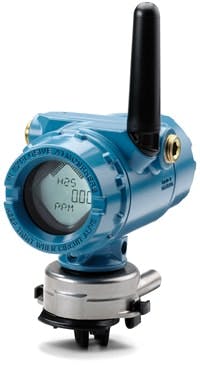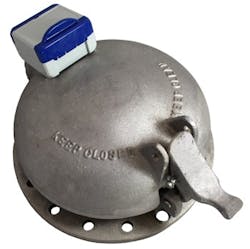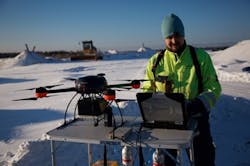Instrumentation: New Capabilities Boost Remote Monitoring
New wireless-enabled sensor technologies are making access to data from remote and difficult-to-reach locations easier — and further advancing the reach of the Industrial Internet of Things (IIOT) at the same time. In fact, wireless monitoring is the key to the IIOT, believes Steve Attri, global product manager at Emerson Automation Solutions, McKinney, Texas, because pervasive sensing techniques based on wireless transmitters allow a plant to monitor anything, anywhere, at a reasonable cost.
For instance, Emerson has launched wirelessly monitored emergency pressure and vacuum relief vents that can be used on storage tanks, including ones located in tricky-to-access parts of a site.
Advances in wireless sensing technology — especially in the gateways that allow connections to ever more wireless devices and communication with critical transmitters — are driving developments such as this, he notes. Other technical improvements include better power module life, which allows wireless transmitters to operate longer at faster update rates, thereby enabling them to transmit data more often, such as once per second for critical measurements.
“Continuous improvement on mitigating interference and overall network improvements means remote wireless transmitters will be able to be installed anywhere, no matter how far the transmitters are located from a control and monitoring system. This opens up wireless monitoring of wellheads, offshore platforms, pipelines, pumping stations and any other system too difficult and expensive to monitor with wired systems,” he explains.
Figure 1. Soon-to-launch device boasts easy sensor replacement as well as true wireless integration. Source: Emerson Automation Solutions.
“Today, a plant can implement a wireless monitoring system for steam traps, pumps, pressure relief devices and other equipment for a fraction of the total wired monitoring solution cost,” he adds.
However, the massive amount of data available to a large wireless installation with hundreds of wireless transmitters must be managed carefully, Attri cautions. “This requires a full software solution, ranging from apps analyzing specific subsystems to larger, plant-wide and worldwide software solutions analyzing plant performance and sharing data over the IIOT with other plants and sites in the company’s network,” he notes.
Gas Detection
One of the big recent changes is wireless communication beginning to be adopted for flame and gas detection for both combustible and toxic gas measurement, says Sean McLeskey, Shakopee, Minn.-based product manager for Emerson.
Just a few years ago, wireless communication only was available on a few semi-permanent devices with short battery life and limited sensor performance, he explains. Some customers made conventional fixed gas detectors “wireless” by using adapters — gaining the benefit of wireless communication but with the hassle of a hook up to a conventional power source.
“Now, with products like our forthcoming Rosemount 928 wireless gas monitor, end-users are able to achieve much better performance with true integrated wireless devices,” he notes. In the new monitor, which is in final stages of product development, sensors are hot-swappable and can be replaced in the field, with one hand, without the need for tools (Figure 1). The 928 also has an optional discrete output for triggering local alarms.
“Our customers are going to have more options than they had in the past when they think about what can be accomplished in flame and gas detection. Wireless is a big part of that progression and it is already allowing our customers to protect their people and assets in ways that were impossible even only a few months ago,” McLeskey explains.
Tank Emissions
Meanwhile, SignalFire Wireless Telemetry, Hudson, Mass., started beta-testing in April at undisclosed customers a patented wireless hatch sensor for remote tank monitoring. Known as Hatch Watchdog, it is designed to prevent dangerous emissions and theft of chemicals from tanks. The sensor remotely monitors the angle of a tank hatch and wirelessly reports the hatch’s status — open/closed/cracked — to a central gateway so operators can immediately respond to any deviations from the closed position (Figure 2).
Figure 2. Sensor monitors tank hatch angle and wirelessly reports whether hatch is fully open, cracked open or closed. Source: SignalFire Wireless Telemetry.
The sensor, for which C1D1 certification for hazardous locations is pending, reportedly has an operating range of half a mile and a battery life of more than five years. In addition, it attaches easily to the hatch with an epoxy adhesive, eliminating the need for tools.
“Tank hatches, or thief hatches, are important because if they [hatches] remain ajar they can release vapors into the atmosphere. Such emissions are covered by stringent regulations and can result in heavy fines — $15,000 in the state of Colorado, for example,” explains SignalFire CEO Scott Keller.
Hatch Watchdog comes as an integrated unit. “You don’t need to mount a sensor and target — often a magnet — on two different parts of the hatch and, being wireless, installation is fast and simple,” he adds.
Hatch Watchdog ultimately could be integrated with other monitoring sensors, says Keller: “For example, the hatch status is of interest as well as the pressure inside the tank. We might want to integrate the hatch status sensor with a pressure sensor with both sets of data being transmitted by a single unit.”
Broad Monitoring
IntelliView, Calgary, Alberta, has combined advanced video analytics and image processing technologies with thermal and color cameras to deliver live video feed analysis, real-time detection of user-defined events or objects, and instant reporting on alarm conditions at unmanned or semi-manned facilities. The system, now available through Emerson in western Canada and Schneider Electric, can handle a variety of duties, e.g., monitoring for leaks in liquid and wet gas pipelines, security intrusions at remote assets, flare stack flames and thermal temperature changes.
TransCanada Corp., Calgary, selected Intelliview’s camera systems in late 2015 for a year-long trial covering real-time pipeline leak detection and perimeter intrusion detection at one of its Alberta Keystone pipeline pump stations (Figure 3).
Figure 3. TransCanada has completed a year-long trial of camera systems to detect leaks and intrusions. Source: IntelliView.
“TransCanada’s leak detection team completed their internal report on the trial at the end of 2016. Although we can’t talk in detail about how the deployment went, based on the findings we have seen, we are very pleased with both the performance and results from our technology and so are optimistic for good things in 2017 and 2018,” says IntelliView vice president sales and marketing Christopher Beadle.
TransCanada had two main priorities during the trial, he explains: “Firstly was the ability of our technology to see leaks — and they carried out a lot of simulations on this using various flow rates and simulated leak sizes. Secondly was our ability to keep false alarms to an extremely low level. This has always been one of our major differentiators, but over the period of the pilot we really got to appreciate how seriously false alarms are taken in this industry. We were good before, but even better following the trial.”
Beadle cites two main two drivers for chemical makers to choose IntelliView technology: demands from regulators and the companies’ own desire to boost environmental protection. “Typically, regulators respond to hazardous material leaks in unmanned areas by requiring the operator to have ‘continuous eyes on the site.’ That’s where our camera/analytic solution provides a very cost effective solution.” In addition, leading companies are seeking new ways to enhance their environmental efforts, he notes. “This is happening now and is indicative of industry-leading organizations committing to investigating the latest tools to enhance worker and environmental safety. Once they adopt the technology, I think it will eventually become more widely used.”
“Remember we are foremost an analytics company, so we are always refining what we can do; the aim here is for even fewer false alarms, increased camera sensitivity to detect even smaller leaks, and a series of object classifiers that will be able to distinguish between humans and animals, or other heat sources,” says Beadle.
Drones Arrive
For remote and difficult-to-access areas, drone-mounted sensors increasingly are becoming an option, too.
Aeromon, Helsinki, Finland, already has used its drone-mounted BH-8 sensor technology as a platform to monitor emissions from a variety of different sites, including refineries, gas transportation infrastructure, biomass storage and municipal waste treatment. BH-8 currently can measure 70 different gaseous compounds, together with particulate matter (Figure 4).
Figure 4. Drone-mounted sensor currently can measure 70 different gaseous compounds as well as particulates. Source: Aeromon.
The sensor package has been specifically designed for both airborne and stationary measurements, and can simultaneously carry eight different gas sensors, radio communications and geolocation technology — all in a package that weighs under 800 g (1¾ lb). In addition, BH-8 is fully integrated with Aeromon’s Gasmon software and cloud service, providing automated web reports with data visualization.
The major advantage to chemical companies is the ability to measure or create a concentration map from a large area very quickly and cost-effectively, says R&D director Matti Irjala. “Our combination of static, hand-held and drone-mounted geospatial measurement configurations together with our real-time cloud-based analysis and emission visualization service — Aeromon cloud service (ACS) — enables our clients to save time and resources.”
“We have the same performance characteristics as with cost-effective wireless sensors but our solution allows our clients to get more complete results quicker than ever before, as difficult locations can be now easily reached and mapping can be done swiftly. Also, our cloud-based automatic reporting and calibration management makes the workflow leaner, which in turn gives companies more time to focus on actions based on their newly acquired information,” Irjala adds.
Regulations on the use of drones vary from country to country; in some nations, aviation laws require a person to have a license to operate a drone, he points out, adding that some harmonization efforts now are underway in Europe.
“Drones are an essential part of the ongoing IIOT revolution,” stresses Irjala.







